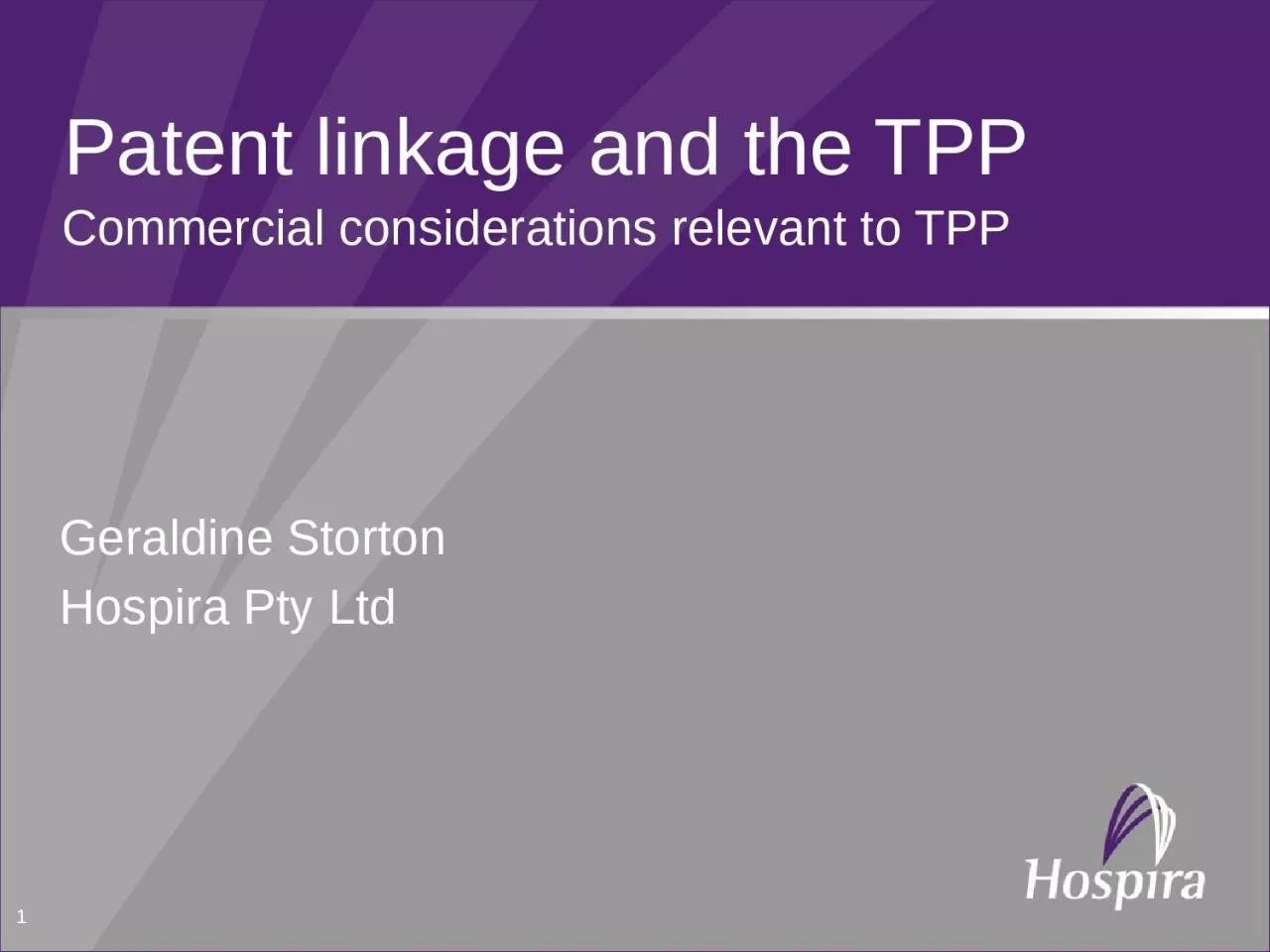

Commercial considerations relevant to TPP 1 Geraldine Storton Hospira Pty Ltd Overview Who is Hospira What is patent linkage Relative market sizes of TPP members Patent linkage hypothetical financial analysis ID: 1035710
Download Presentation The PPT/PDF document "Patent linkage and the TPP" is the property of its rightful owner. Permission is granted to download and print the materials on this web site for personal, non-commercial use only, and to display it on your personal computer provided you do not modify the materials and that you retain all copyright notices contained in the materials. By downloading content from our website, you accept the terms of this agreement.
1. Patent linkage and the TPPCommercial considerations relevant to TPP1Geraldine StortonHospira Pty Ltd
2. OverviewWho is Hospira?What is patent linkage?Relative market sizes of TPP membersPatent linkage hypothetical financial analysisImplications of patent linkage hypothetical for HospiraDiscussionConclusions2
3. Our companyWorld's Leading Provider of Injectable Drugs and Infusion Technologies Market leadership positions in:Generic injectable pharmaceuticals globallyBiosimilars in Europe and AustraliaMedication management systems globallyDistinguished 70-year historyPioneer in innovation and safetyPublicly traded since 2004~$4 billion in annual revenuesLarge, growing global markets~15,000 employees, 13 manufacturing facilitiesHeadquartered in Lake Forest, Ill., USAImproving the safety, cost and productivity of patient care3
4. Patent linkage and the TPP – what is patent linkage?US FTAs - trend is to include “patent linkage” provisions requiring patent linkagePatent linkage makes regulatory approval dependant on the domestic patent positionPatent linkage has been implemented in the US, CA and SG with the following featuresCompulsory generic notification if intent to market pre patent expiryCompulsory stay on regulatory approval if generic suedStay is a very effective motivation to sue (equates to compulsory litigation spend)US only provides generic market exclusivityUS New Trade Policy 2007 proposes no inclusion of patent linkage in FTAsPatent linkage in ex-US TPP countries will be detrimental to a generic manufacturer’s ability to bring affordable, high quality generics to market.4
5. Patent linkage works when the market size is large, and the pay-off from a single molecule is significant5 Source: Business Monitor International, IMS HealthCompared to other countries in the TPP group, the annual market valuefor pharmaceuticals in the US is significantly higher.*Note no data available for Brunei
6. Patent linkage - toward a hypothetical modelHSP developed a hypothetical model to determine the impact of patent linkage on generics industries in TPP membersGoal – to determine the commercial return on “litigation” investment (if any) bearing in mind:Litigation costs Market value of a product at patent expiryMarket share obtainedDegree of price discounting Profit marginProbability of success in litigation Any “generic exclusivity” on offer 6
7. Commercial implications of Patent Linkage Hypothetical – Results7The current GMiA estimated typical cost of litigation in Australia is $5M*. Using typical industry ranges for market size, development cost, market share, price erosion and margins a financial model was created. This model did not return a positive profit for the generic manufacturer unless the cost of litigation was low, or the exclusivity period was long. Green shading signifies a positive pay-off (i.e. The pay-off, including the cost of litigating, returns a profit for the generic manufacturer)A threshold value was determined to understand the market value of a drugrequired to provide a positive return at USD 5M litigation cost and 0.5 years Exclusivity. For the base case this was >USD 200M. Source: Mean litigation cost estimates provided by GMiA. IMS data for number of molecules selling over $200 M paThere are no injectable products* in Australia selling in excess of $200 M pa.
8. Commercial implications of Patent Linkage Hypothetical – sensitivity analysis8For the base case USD 50M product, we varied the input parameters across plausible ranges to understand the sensitivity of the model.We found that with higher value inputs, a negative return is still expected at Current litigation costs and 6 months exclusivity (as the US has). *Source: Legal Fee estimates from GMiA. IMS data for number of molecules selling over $50 M paThere are only 13 injectable products* in Australia selling in excess of $50 M pa.
9. Patent Linkage – Implications for HospiraHospira conducted a hypothetical analysis of all of its actual launched products in ex-US TPP countries in the last 4 years. Under a patent linkage system with compulsory litigation and generic exclusivity, none of the products launched in the last 4 years would have had positive financial return associated them.9
10. Patent linkage will not work in any country other than the USPatent linkage works in the US only because of the size of the US marketThe size of the prize is incomparableThe US is 50% of WW pharma market & totally eclipses ROW pharma markets Patent linkage will be very problematic for every other TPP member, including AustraliaThe relative size of the market is significantly smaller Compulsory patent litigation is cost prohibitiveGeneric market entry will be delayed or eliminated10
11. Patent linkage will not work in any country other than the USThis generic entry delay (due to patent linkage) will cripple government spending on pharmaceuticals because it will: Deny the public timely access to cost effective medicinesInflate health care costsBe detrimental to government’s ability to manage spending on pharmaceuticals11
12. ConclusionPatent linkage in ex-US TPP countries will be detrimental to a generic manufacturer’s ability to bring affordable, high quality generics to market.The effect of patent linkage will be inequality in health care: patent linkage will not affect access to affordable medicines in the US, the US public will continue to have access to these medicines, whilst the people of other TPP members will not. 12
13. Thank youGeraldine StortonHospira Pty Ltd13